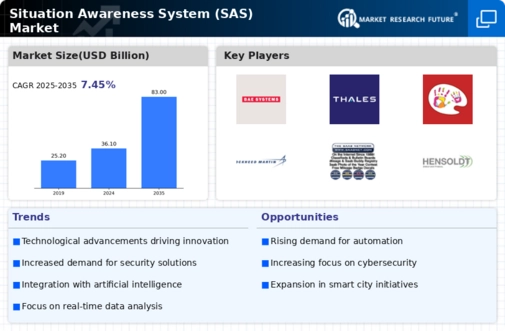Advancements in Sensor Technology
Technological advancements in sensor technology are playing a pivotal role in shaping the Situation Awareness System (SAS) Market. The integration of sophisticated sensors, such as LiDAR, infrared, and multi-spectral imaging, enhances the ability to gather and interpret data from diverse environments. These innovations enable organizations to achieve a higher level of situational awareness, particularly in sectors like defense and public safety. The market for sensor technology is expected to witness substantial growth, with projections indicating a potential increase of 20% annually. This growth is largely attributed to the rising demand for accurate and reliable data collection methods. Consequently, SAS solutions that leverage cutting-edge sensor technology are likely to gain traction, as they provide users with comprehensive insights necessary for effective decision-making.
Increasing Demand for Real-Time Data
The Situation Awareness System (SAS) Market is experiencing a notable surge in demand for real-time data processing capabilities. Organizations across various sectors, including defense, transportation, and emergency services, are increasingly reliant on timely information to make informed decisions. This trend is driven by the need for enhanced situational awareness, which is critical in high-stakes environments. According to recent estimates, the market for real-time data analytics is projected to grow at a compound annual growth rate of over 25% in the coming years. This growth is indicative of a broader shift towards data-driven decision-making, where the ability to access and analyze information instantaneously is paramount. As a result, SAS solutions that offer robust real-time data capabilities are likely to see heightened adoption, further propelling the market forward.
Integration of Advanced Analytics and AI
The Situation Awareness System (SAS) Market is witnessing a transformative shift with the integration of advanced analytics and artificial intelligence (AI) technologies. These innovations enable organizations to process vast amounts of data and derive actionable insights, enhancing situational awareness across various applications. The adoption of AI-driven SAS solutions is projected to grow significantly, with estimates suggesting a market expansion of over 30% in the next few years. This growth is fueled by the increasing need for predictive analytics and automated decision-making capabilities in sectors such as defense, transportation, and public safety. As organizations seek to leverage data for strategic advantage, the integration of advanced analytics into SAS solutions is likely to become a key differentiator, driving further investment and development in the market.
Regulatory Compliance and Safety Standards
The Situation Awareness System (SAS) Market is significantly influenced by the increasing emphasis on regulatory compliance and safety standards across various sectors. Governments and regulatory bodies are mandating stringent safety protocols, particularly in industries such as aviation, maritime, and critical infrastructure. This regulatory landscape compels organizations to adopt SAS solutions that ensure compliance with safety regulations and enhance operational efficiency. For instance, the aviation sector is witnessing a growing need for SAS technologies to meet safety standards set by international aviation authorities. The market for compliance-driven SAS solutions is projected to expand, with estimates suggesting a growth rate of approximately 15% over the next few years. This trend underscores the importance of situational awareness in maintaining safety and operational integrity, thereby driving the adoption of SAS technologies.
Growing Focus on Emergency Response and Management
The Situation Awareness System (SAS) Market is increasingly shaped by a growing focus on emergency response and management capabilities. As natural disasters and emergencies become more frequent, the need for effective situational awareness tools has never been more critical. Organizations involved in disaster response, such as government agencies and NGOs, are investing in SAS solutions to enhance their operational readiness and response times. Recent data indicates that the emergency management sector is expected to grow at a rate of 18% annually, driven by the need for improved coordination and information sharing during crises. This trend highlights the essential role of SAS technologies in facilitating timely and informed decision-making during emergencies, thereby propelling the market forward.


















Leave a Comment